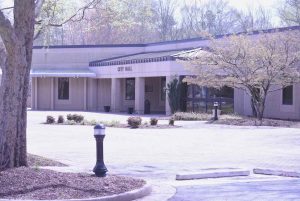Peachtree City Council retreat focuses on traffic solutions, likely redevelopment areas
An April 3 retreat of the Peachtree City Council came with a look at transportation projects to provide both access and mobility and a look at different redevelopment tools the city might use in the future to address some of the city’s aging residential and commercial areas.
Above, members of the Peachtree City Council listen to a presentation during the April 3 planning retreat. Photo/Ben Nelms.
With a few updates, much of the presentation was essentially a continuation of some aspects of the city’s 2014 transportation study.
As they have done on numerous occasions, city staff were clear that roadways such as Ga. highways 54 and 74 are not owned by the city or county, but are state roads controlled and improved only by the Ga. Department of Transportation (DOT).
The largest project on the near-term horizon is the $10 million improvement at highways 54 and 74, previously announced by DOT.
A Continuous Flow Intersection (CFI) design, expected in the 2020 time frame, moves left-turn vehicles across the opposing direction of traffic approximately 600 feet before reaching the intersection. The design removes the need for a protected left-turn phase and allows the use of a two-phase traffic signal, according to DOT.

City Manager Jon Rorie reiterated that DOT controls what happens at the intersection, including with Commerce Drive that intersects with Hwy. 54 just east of the intersection. Commerce could become a right-in, right-out only access point.
Staff said DOT is procuring an engineering firm to the do final design, which is expected to begin in the summer.
A local project first proposed in 2004 will have a roundabout installed at Crosstown Drive and South Peachtree Parkway.
The city is currently completing an intergovernmental agreement with Fayette County for a $1.5 million roundabout project and is finalizing a design proposal with Integrated Science and Engineering. To date, there has been no timeline established for the project.
South Kedron Drive at Ga. Highway 74 North was also referenced in terms of the potential for installing a Restricted Crossing (R-Cut) intersection. If engaged at some point in the future, left turns out of South Kedron onto Hwy. 74 southbound would no longer be possible.
Rorie noted that adding a traffic signal to the intersection would likely not occur, adding that DOT prefers R-Cuts over traffic signals because they improve vehicular mobility through the area.
Explaining that such a project is conceptual, Rorie said there is no current funding and that, if desired, the city would need to make a proposal to DOT.
It would be along Hwy. 54 East that R-Cuts and other access management tools, including limiting new traffic signals, might be used in the future.
Rorie suggested that it is likely a matter of time before a tunnel or bridge will be needed for the Lexington area where golf carts are currently allowed by DOT to make at-grade crossings at Hwy. 54. That time will eventually end as traffic volumes increase.
On another matter, council members at the retreat heard reports on the use of tools such as Community Improvement Districts (CIDs), Tax Increment Financing and Tax Allocation Districts (TIF/TADs).
Rorie explained that the purpose of including CIDs and TADs on the agenda was to provide an idea for looking at potential options for the city’s future.
Atlanta-based Council for Quality Growth representative Taylor Morison briefed the council on CIDs and TIF/TADs.
A CID is formed by commercial and/or industrial property owners to provide enhancements specific to the CID area such as the construction of roadways, traffic flow measures, sidewalks or stormwater systems.
While the CID would also include city or county representatives on the board, the CID board is largely made up business members which levy taxes only on themselves to accomplish needed improvements within the CID geographical area.
“The dollars raised there have to be spent there,” Morison said, emphasizing that only commercial and industrial properties are subject to a CID tax levy.
An area in Peachtree City cited by Morison as a potential CID is the commercial area at highways 54 and 74.
Turning to the topic of TADs/TIFs, Morison said the district is a geographical area established by the city for redevelopment for which bonds are sold to finance infrastructure and other redevelopment costs.
TADs are used to encourage commercial development in undeveloped or under-developed areas or those in need of redevelopment. A TAD requires voter approval through a local referendum.
Perhaps the best-known example of a TAD in Georgia is Atlantic Station in Atlanta.











Leave a Comment
You must be logged in to post a comment.